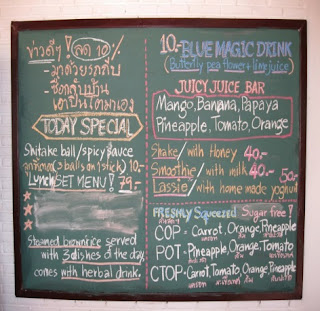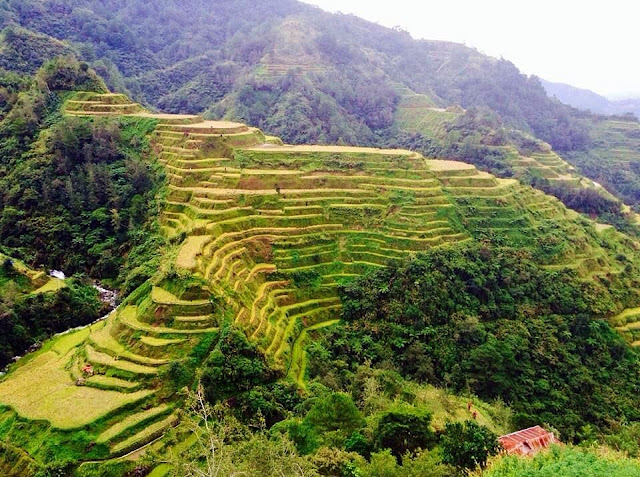CHIANG MAI FLAVORS: G O D FOR A DRINK
CHIANG MAI FLAVORS, PART 1: G O D FOR A DRINK
I feel like a stranger feeling at home at the Brown Rice Organic Bistro. In many ways, BROB feels like a perfect expression of Berkeley, California gourmet ghetto. It's a small place, with no fancy décor, with an open-air patio that faces a busy street. It has 3 medium size tables, and two 'khan toke' (low round tables made of wood to hold a plethora of dishes). It's always filled with tourists who seemed like they just came back from a meditation or yoga class or from walking their dog.
 It starts being special from the bar chalkboard menu. The smoothie menu on the chalkboard includes catchy labels like GOD (Green Oasis Drink), POT (Pineapple, Orange and Tomato), and CTOP (Carrot, Tomato, Orange and Pineapple). It also describes the type of nutrients that could be found in a serving of a fruit juice. For example, “Gac fruit juice has 12 times the amount of lycopene found in tomatoes or 10x the beta-carotene found in carrots.”
It starts being special from the bar chalkboard menu. The smoothie menu on the chalkboard includes catchy labels like GOD (Green Oasis Drink), POT (Pineapple, Orange and Tomato), and CTOP (Carrot, Tomato, Orange and Pineapple). It also describes the type of nutrients that could be found in a serving of a fruit juice. For example, “Gac fruit juice has 12 times the amount of lycopene found in tomatoes or 10x the beta-carotene found in carrots.”Of course, as good as the smoothie drinks are the focus here is still on the food. Written on the chalkboard is a notice, “Every dish is prepared from scratch by Master Chef Duang.” The menu selection is not large, but offers a wide variety of signature dishes, including tofu fou (crispy tofu topped with tangy green mango salad); fresh spring rolls with tamarind sauce; and eggplant hinlay curry (ginger-based curry full of eggplant, tofu and hearty mushrooms). Desserts include the very delicious sticky rice with mango and chocolate brownie.
 |
| Tofu Fou |
 |
| Blue Magic and Eggplant w/ Tofu |
 |
| Owner and Master Chef Duang |
Having discovered the flavors of Northern Thailand by eating organic, vegetarian and gourmet foods, prepared by a master chef, through an organic bistro, put a smile on my face. I’m a foodie and not a vegetarian after all!
********************
Chiang Mai Flavors, Part 2: 10 Things I learned from The Thai Farm Cooking School
 |
| Photo collage and all photos by the author |
2. It was a great way to meet other travelers. We were taken out to the farm, about 45 minutes from the city of Chiang Mai. Along the way, our covered-truck picked up six more passengers from their respective hotels: a German couple, a young American tourist, two Expats taking a brother in-law to a cooking school. We had time to socialize while pounding our curry paste.
3. I didn’t have to worry about shopping for ingredients.
At the back of the market, I saw a cluster of stalls with beautifully stacked fruits. My eyes popped at how luscious and vibrant in color the vegetables and fruits of immense shapes and sizes were: papaya, banana, star fruit, durian, mangoes, mangosteen, rambutan, longkong. I bought a kilo of longkong and went to the corner to eat my fruit while waiting for the truck and the rest of the group. I peeled out the yellow skin of the fruit to reach the sweet translucent white meat. It had a tiny seed that was very bitter, but I learned how to eat around the seed to savor its sweet and flavorful unique taste. I ate and ate until I had mountains of the fruit skins surrounding me.
4. The atmosphere was relaxed
 |
| Em & my new obsession (Galangal) |
When we arrived at
the farm, we were ushered to a terrace above a fishpond. We were offered some cold water and tea. Each
participant was given a red apron and a straw hat. We then toured the farm. Our instructor showed us a pandan plant (a plant with an aromatic
and vanilla-like flavor); Kaffir plant for which the leaves and fruits are
important ingredients to a Tom Yam
recipe. All the
ingredients needed for our recipes could be found in the vegetable garden: eggplant, lemon grass, galangal (my new obsession), chili, basil,
cucumber, morning glory, beans, coriander, pumpkin, spring onion, ginger. There was an abundance of fruit trees
like rose-apple, mango, gooseberry, jackfruit, banana, guava, star fruit, rambutan,
lime, papaya and coconut. Unfortunately, we didn’t get to pick any
fruits or vegetables for our recipe.
 |
| Ingredients to make yellow curry paste |
5. I learned how to
cook some of the best local dishes
We were given a
checklist of recipes that we wanted to cook before arriving at the farm. I checked-off five dishes.
- yellow curry
- tom yam with shrimp
- chicken stir fried,
- large noodle pad Thai
- pumpkin with coconut milk for dessert
Back at the
terrace above the fishpond, we started our first lesson on how to make curry
paste. I pound and pound and pound the ingredients that
were already cut and prepared for us to make curry paste.
6. It was a great way to learn from a
local.
Our
instructor was from the area. She said
she used to sell food at the market before becoming a cooking instructor. So
she has a lot of food-related knowledge.
Also, she’s married to a Frenchman.
I thought that should have given her a heightened awareness of her own culture
and about cultural differences. She had
a great interpersonal skill and sense of humor.
She told us a few tales like “A good
cook is always considered a good wife”, “The neighbor could tell if the wife is
a good cook by the amount and loud sound of pounding to make curry paste.”
Our
second lesson was a demonstration on cooking sticky rice using a typical Thai
steamer. The sticky rice had been soaked in water overnight. She emphasized the importance of using the
correct amount of water, and demonstrated the knuckle test.
Our lesson began in the kitchen with a
demonstration by Em. She cooked
stir-fry for her demonstration. I
thought it made sense to cook stir-fry to show us some safety tips as well like
‘how to handle hot oil’. Each of us was
assigned a burner. Everything we needed
for our cooking was already cut and pre prepared and sitting at our station and
ready to go. The clean-up was left in the hand of someone
else.
8. I got to eat plenty of good food
I wished Em told us from the onset
that we would be eating all day. I
should not have eaten all that longkong. After cooking our dish, we immediately plated
and ate it at the terrace.
9. We were given a demonstration on how to pack a dish to-go. I took my Pad-Thai to my guesthouse.
10. We were given a recipe book to take home as souvenir.
9. We were given a demonstration on how to pack a dish to-go. I took my Pad-Thai to my guesthouse.
10. We were given a recipe book to take home as souvenir.
NOTES: All photos by the author
The Brown Rice Organic Bistro is located on 85/5 Samlarn Road, Pha Sing, Mueang Chiang Mai, Chiang Mai, Thailand







Comments
Post a Comment